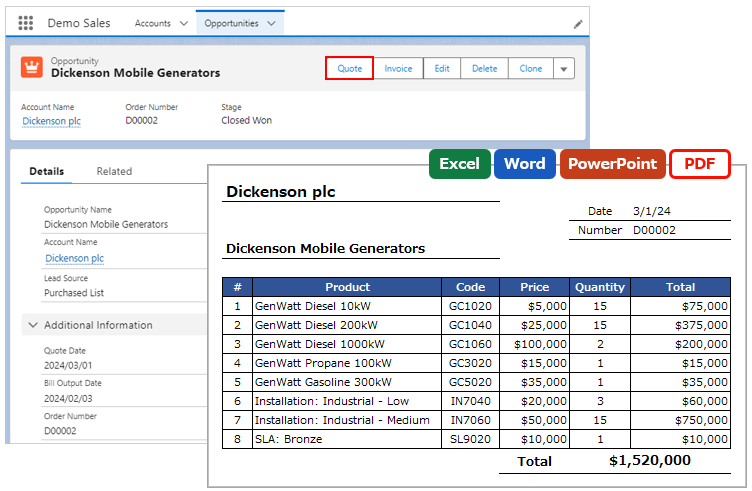Word、PowerPoint、PDF出力時、データ型が通貨・数値の差し込み項目に書式を設定することが可能です。
※本機能はOffice File Creator Ver.2の機能です。Ver.1は、通貨・数値項目の書式設定 (Ver.1)を参照してください。
使用例
- 通貨項目の小数点桁数を2桁で四捨五入したい。
通貨・数値項目のデフォルト書式
Word、PowerPoint、PDF出力時、通貨・数値項目はデフォルトで以下の書式が適用されます。
- 1000以上の値は3桁カンマ区切りで出力されます。
- 小数点以下の桁数は項目定義に従って出力されます。レコード値に項目定義の桁数を超える値が保存されている場合、項目定義の桁数で四捨五入されます。
※Excel出力時は、書式設定なしでレコード値がそのまま出力されます。
差し込み項目の設定
テンプレートファイルに以下の形式で通貨・数値型の差し込み項目を設定します。
差し込み項目形式
{!オブジェクトAPI名.項目API名, 書式;マイナス書式, 丸めモード}
※書式、丸めモードは、ダブルクオテーション「""」やシングルクオーテーション「''」で囲まず、直接設定してください。
書式;マイナス書式
3桁区切り、小数点以下の桁数、小数点以下の丸めモードを指定します。マイナス書式は省略可能です。マイナス書式は正の値と異なる場合のみ指定してください。通貨記号を出力する場合は、書式の前後に付与します。
###0 ・・・ 小数点以下を四捨五入
#,##0 ・・・ 1000以上3桁カンマ区切り、小数点以下を四捨五入
#,##0.0 ・・・ 1000以上3桁カンマ区切り、小数第1位で四捨五入。"0."の後に表示桁数分0を付与。
#,##0;▲#,##0 ・・・ 1000以上3桁カンマ区切り、小数点以下を四捨五入。マイナス記号は▲で表示。
例:{!Case.TestCurrency__c, \#,##0.0}
出力結果 \1,234.5
丸めモード
以下のいずれかを指定します。丸めモードは省略可能です。省略した場合、デフォルトの「HALF_UP」が適用されます。
例:{!Case.TestCurrency__c, \#,##0, DOWN}
| 丸めモード | 説明 |
| CEILING | 正の無限大に丸めます。つまり、結果が正の場合、このモードは、UP 丸めモードと同じ動作をします。結果が負の場合、DOWN 丸めモードと同じ動作をします。この丸めモードでは計算値は小さくなりません。次に例を示します。
入力値 5.5: CEILING 丸めモードの結果: 6 入力値 1.1: CEILING 丸めモードの結果: 2 入力値 -1.1: CEILING 丸めモードの結果: -1 入力値 -2.7: CEILING 丸めモードの結果: -2 |
| DOWN | 0 に丸めます。この丸めモードは常に、小数点以下の桁数部分を実行前に破棄します。この丸めモードでは計算値が大きくなることはありません。次に例を示します。
入力値 5.5: DOWN 丸めモードの結果: 5 入力値 1.1: DOWN 丸めモードの結果: 1 入力値 -1.1: DOWN 丸めモードの結果: -1 入力値 -2.7: DOWN 丸めモードの結果: -2 |
| FLOOR | 負の無限大に丸めます。つまり、結果が正の場合、このモードは、DOWN 丸めモードと同じ動作をします。結果が負の場合、UP 丸めモードと同じ動作をします。この丸めモードでは計算値は大きくなりません。次に例を示します。
入力値 5.5: FLOOR 丸めモードの結果: 5 入力値 1.1: FLOOR 丸めモードの結果: 1 入力値 -1.1: FLOOR 丸めモードの結果: -2 入力値 -2.7: FLOOR 丸めモードの結果: -3 |
| HALF_DOWN | 「最も近い近似値」に丸められます。ただし、2 つの近似値が等距離にある場合は、このモードでは切り捨てられます。破棄される小数点以下の値が 0.5 より大きい場合、この丸めモードは、UP 丸めモードと同じ動作をします。0.5 以下の場合、DOWN 丸めモードと同じ動作をします。次に例を示します。
入力値 5.5: HALF_DOWN 丸めモードの結果: 5 入力値 1.1: HALF_DOWN 丸めモードの結果: 1 入力値 -1.1: HALF_DOWN 丸めモードの結果: -1 入力値 -2.7: HALF_DOWN 丸めモードの結果: -3 |
| HALF_EVEN | 「最も近い近似値」に丸められます。ただし、2 つの近似値が等距離にある場合は、このモードでは偶数の近似値に丸められます。破棄される小数点以下の値の左側が奇数の場合、この丸めモードは、HALF_UP 丸めモードと同じ動作をします。偶数の場合、HALF_DOWN 丸めメソッドと同じ動作をします。次に例を示します。
入力値 5.5: HALF_EVEN 丸めモードの結果: 6 入力値 1.1: HALF_EVEN 丸めモードの結果: 1 入力値 -1.1: HALF_EVEN 丸めモードの結果: -1 入力値 -2.7: HALF_EVEN 丸めモードの結果: -3 |
| HALF_UP | 「最も近い近似値」に丸められます。ただし、2 つの近似値が等距離にある場合は、このモードでは切り上げられます。破棄される小数点以下の値が 0.5 以上の場合、この丸めメソッドは、UP 丸めメソッドと同じ動作をします。0.5 より小さい場合、DOWN 丸めメソッドと同じ動作をします。次に例を示します。
入力値 5.5: HALF_UP 丸めモードの結果: 6 入力値 1.1: HALF_UP 丸めモードの結果: 1 入力値 -1.1: HALF_UP 丸めモードの結果: -1 入力値 -2.7: HALF_UP 丸めモードの結果: -3 |
| UP | 0 から遠い方向に丸めます。この丸めモードは常に、小数点以下の桁数部分を実行前に切り捨てます。この丸めモードでは計算値が小さくなることはありません。次に例を示します。
入力値 5.5: UP 丸めモードの結果: 6 入力値 1.1: UP 丸めモードの結果: 2 入力値 -1.1: UP 丸めモードの結果: -2 入力値 -2.7: UP 丸めモードの結果: -3 |
丸めモードはSalesforceの仕様に従います。
差し込み項目の例
例:オブジェクトがCase、項目がTestCurrency__c(通貨)で、項目値が1234567.89の場合
※丸めモードを省略した場合、デフォルトの「HALF_UP」四捨五入が適用されます。
| 書式 | 出力結果 | 差し込み項目例 |
| \###0 | \1234568 | {!Case.TestCurrency__c, \###0} |
| \#,##0 | \1,234,568 | {!Case.TestCurrency__c, \#,##0} |
| \#,##0.0 | \1,234,567.9 | {!Case.TestCurrency__c, \#,##0.0} |
| \#,##0.00 | \1,234,567.89 | {!Case.TestCurrency__c, \#,##0.00} |
| \#,##0.000 | \1,234,567.890 | {!Case.TestCurrency__c, \#,##0.000} |
| \#,##0.0000 | \1,234,567.8900 | {!Case.TestCurrency__c, \#,##0.0000} |
| \#,##0, DOWN | \1,234,567 | {!Case.TestCurrency__c, \#,##0, DOWN} |
| \#,##0;▲\#,##0, DOWN | \1,234,567
マイナス値: ▲\1,234,567 |
{!Case.TestCurrency__c, \#,##0;▲\#,##0, DOWN} |
備考
Excel出力時は、差し込み項目に書式設定はできません。テンプレートファイルのセルの書式を設定してください。
